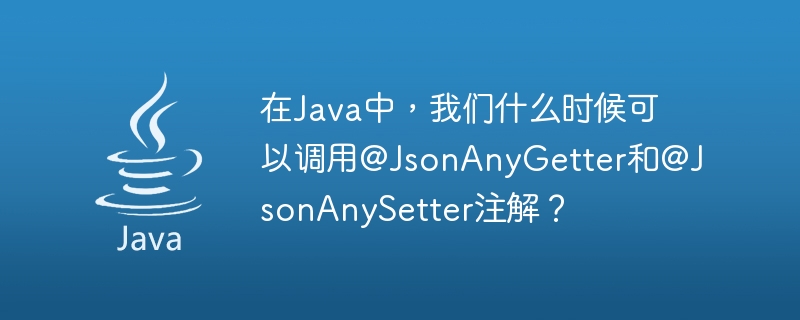Heim >Java >javaLernprogramm >Wann können wir in Java die Annotationen @JsonAnyGetter und @JsonAnySetter aufrufen?
Wann können wir in Java die Annotationen @JsonAnyGetter und @JsonAnySetter aufrufen?
- 王林nach vorne
- 2023-09-06 22:13:111321Durchsuche

@JsonAnyGetter Die Annotation ermöglicht die Verwendung einer Map als Container für Eigenschaften, die wir in JSON und @JsonAnySetter serialisieren möchten Annotation weist Jackson an, dieselbe Setter-Methode für alle unerkannten Felder im JSON-Objekt aufzurufen, d. h. für alle Felder, die nicht Eigenschaften oder Setter-Methoden im Java-Objekt zugeordnet sind.
Syntax
public @interface JsonAnyGetter public @interface JsonAnyGetter
Beispiel
import java.io.*;
import java.util.*;
import com.fasterxml.jackson.core.*;
import com.fasterxml.jackson.databind.*;
import com.fasterxml.jackson.annotation.*;
public class JsonAnyGetterAndJsonAnySetterTest {
public static void main(String args[]) throws JsonGenerationException, JsonMappingException, IOException {
Employee emp1 = new Employee();
emp1.setFirstName("Adithya");
emp1.setLastName("Sai");
emp1.setEmpId(125);
emp1.getAdditionalInformation().put("technology1", "Machine Learning");
emp1.getAdditionalInformation().put("technology2", "Robotics");
ObjectMapper mapper = new ObjectMapper();
String jsonStr = mapper.writerWithDefaultPrettyPrinter().writeValueAsString(emp1);
System.out.println(jsonStr);
System.out.println("Deserializing JSON to Object:");
Employee emp2 = mapper.readValue(jsonStr, Employee.class);
System.out.println("id : " + emp2.getEmpId());
System.out.println("firstName : " + emp2.getFirstName());
System.out.println("lastName : " + emp2.getLastName());
System.out.println("Additional information : " + emp2.getAdditionalInformation());
}
}
// Employee class
@JsonInclude(JsonInclude.Include.NON_NULL)
@JsonPropertyOrder({"firstName", "lastName", "technologies", "empId" })
class Employee {
@JsonProperty("EMPLOYEE_ID")
private int empId;
@JsonProperty("EMPLOYEE_FIRST_NAME")<strong>
</strong> private String firstName;
<strong> </strong> @JsonProperty("EMPLOYEE_LAST_NAME")<strong>
</strong> private String lastName;
private Map<String, String> additionalInformation = new HashMap<>();
public int getEmpId() {
return empId;
}
public void setEmpId(int empId) {
this.empId = empId;
}
public String getFirstName() {
return firstName;
}
public void setFirstName(String firstName) {
this.firstName = firstName;
}
public String getLastName() {
return lastName;
}
public void setLastName(String lastName) {
this.lastName = lastName;
}
<strong> </strong> @JsonAnyGetter<strong>
</strong> public Map<String, String> getAdditionalInformation() {
return additionalInformation;
}
public void setAdditionalInformation(Map<String, String> additionalInformation) {
this.additionalInformation = additionalInformation;
}
<strong> </strong>@JsonAnySetter
public void setAdditionalProperty(final String name, final String value) {
this.additionalInformation.put(name, value);
}
}Ausgabe
{
"EMPLOYEE_FIRST_NAME" : "Adithya",
"EMPLOYEE_LAST_NAME" : "Sai",
"EMPLOYEE_ID" : 125,
"technology1" : "Machine Learning",
"technology2" : "Robotics"
}
Deserializing JSON to Object:
id : 125
firstName : Adithya
lastName : Sai
Additional information : {technology1=Machine Learning, technology2=Robotics}Das obige ist der detaillierte Inhalt vonWann können wir in Java die Annotationen @JsonAnyGetter und @JsonAnySetter aufrufen?. Für weitere Informationen folgen Sie bitte anderen verwandten Artikeln auf der PHP chinesischen Website!
Stellungnahme:
Dieser Artikel ist reproduziert unter:tutorialspoint.com. Bei Verstößen wenden Sie sich bitte an admin@php.cn löschen
Vorheriger Artikel:@SafeVarargs-Annotation für private Methoden in Java 9?Nächster Artikel:@SafeVarargs-Annotation für private Methoden in Java 9?

